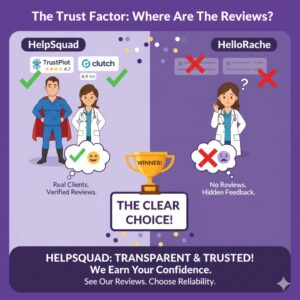Hidden Factors: The Silent Killers of Customer Satisfaction
12 Sep 2024 By: Mary Dellosa
Updated

Customer satisfaction is vital for any business. Understanding and addressing the hidden service gaps that can lead to dissatisfaction is crucial. These gaps, often silent killers, can deteriorate customer trust and loyalty. This article will explore these gaps, their impact, and strategies to eliminate them.
Understanding the Concept of Silent Killers in Customer Satisfaction
Silent killers are unseen factors that damage customer satisfaction. They often go unnoticed until they manifest in poor customer experiences. These gaps can stem from various sources, including ineffective communication and inadequate service delivery.
Defining Silent Killers in the Service Industry
In the service industry, silent killers often relate to unaddressed issues. They could include long wait times or unresponsive support. These problems can erode customer trust over time. Silent killers might also include missed expectations. For instance, if a service fails to meet customer needs, it can lead to disappointment. Companies must identify these issues early to mitigate their effects.
Additionally, the inconsistency in service quality can serve as a silent killer. When customers experience varying levels of service during different interactions, it creates uncertainty and frustration. This inconsistency can stem from a lack of standardized procedures or insufficient training for staff, leading to a disjointed customer experience that undermines loyalty.
The Impact of Silent Killers on Customer Satisfaction
The impact of silent killers can be severe. When customers feel their needs are ignored, they may seek alternatives. This shift not only affects sales but also tarnishes the company’s reputation. Further, unhappy customers often share their experiences. Negative reviews can spread quickly, impacting potential customers. Thus, the company faces not just lost sales, but also future opportunities.
Moreover, the financial implications of silent killers extend beyond immediate losses. Companies often spend more on marketing to replace lost customers, taking focus away from improving their services. This creates a reactive cycle, harming service quality and loyalty.
Identifying Hidden Service Gaps
To tackle service gaps, identifying them is the first step. Businesses must actively seek out signs of dissatisfaction among customers. This process involves observation, listening, and feedback collection. The goal is to find areas that need improvement and fix them. When companies encourage open communication, customers feel safe sharing concerns. This builds trust and loyalty as feedback gets heard and acted on.
Recognizing Symptoms of Service Gaps
Symptoms of service gaps can be subtle. Common signs include repeated complaints or declining sales. Inconsistent service experiences can also indicate underlying issues.
- Long wait times
- Frequent errors
- Lack of staff knowledge
Additionally, a sudden rise in customer churn can signal deeper problems. Companies need to stay on top of things and act fast to catch issues early. Listening to customer calls, reading emails, and talking in person helps them see the full picture. This makes it easier to spot and fix problems before they grow.
Tools and Techniques for Identifying Service Gaps
Effective tools and techniques can aid in identifying service gaps. Customer surveys provide direct feedback on perceptions and experiences.
Additionally, employee feedback can yield insights into operational challenges. Monitoring social media platforms can also highlight customer sentiments and issues. Engaging with customers through online reviews and comments can further illuminate areas for improvement, as these platforms often serve as a public forum for customer experiences. Making feedback collection more accessible—such as by embedding survey links in emails or adding QR codes on receipts and product packaging—can encourage more customers to share their experiences, leading to richer insights.
- Surveys and feedback forms
- Social media monitoring
- Employee interviews and focus groups
By using these methods, businesses can gather valuable insights. This data will guide them in addressing the hidden gaps in service delivery. Regularly training employees based on customer feedback helps them improve their skills and provide better service. By doing this, businesses can fix problems and stay ahead of future challenges, keeping them competitive in a changing market.
The Role of Employee Training in Service Gap Management
Employees are key to keeping customers happy. With the right training, they feel confident and can consistently provide great service. By focusing on skill development, companies can enhance service quality. This step is essential in closing the potential service gaps.
Enhancing Employee Skills for Better Service Delivery
Training sessions should focus on practical skills. Employees must develop communication and problem-solving abilities. These skills allow them to address customer needs effectively. Role-playing scenarios can help staff prepare for real-life situations. This approach builds confidence and ensures they understand the company’s service expectations.
Moreover, incorporating feedback mechanisms into training can significantly enhance the learning experience. when employees share their ideas and challenges, companies can create training that tackles real issues. This open communication helps everyone improve and makes employees feel valued and involved in the company’s success.
The Importance of Continuous Employee Training
Continuous training is key in keeping staff engaged. Regular updates on products, policies, and customer service techniques are crucial. Investment in employee growth shows commitment to service excellence. In turn, skilled employees contribute to higher levels of customer satisfaction.
Creating a learning environment helps employees take charge of their growth. Offering online courses, workshops, and seminars motivates them to improve in their jobs and reach their career goals. This boosts morale and can lead to fresh ideas that solve customer problems.
Strategies for Eliminating Hidden Service Gaps
Eliminating service gaps requires a proactive approach. Businesses must develop strategies that actively address customer feedback and concerns.
Implementing specific initiatives can lead to reduced gaps and increased satisfaction. By encouraging constant improvement, companies can go beyond just meeting customer expectations. This is key to staying competitive today.
Implementing Customer Feedback Systems
Setting up strong feedback systems is important. Companies should offer many ways for customers to share their concerns.
For instance, online surveys, suggestion boxes, and live chats can gather valuable input. Analyzing this feedback helps identify gaps and devise effective solutions. Using social media for feedback gives companies real-time insight into customer feelings. It helps them quickly respond to issues and spot trends.
Leveraging Technology to Improve Service Delivery
Technology can significantly enhance service delivery. Tools like Customer Relationship Management (CRM) systems help track interactions and preferences. This allows for personalized service that meets customer needs.
Moreover, integrating chatbots for 24/7 support can reduce wait times. Customers appreciate quick responses, which directly contributes to satisfaction. Using data analytics helps businesses predict customer needs and preferences. This lets them customize services and fix problems before they arise.
Measuring the Success of Service Gap Elimination Strategies
After implementing strategies, measuring success is key. Businesses need clear goals to track service improvements. Along with data, customer feedback through surveys or focus groups gives deeper insights. This helps fine-tune their approach beyond just numbers.
Tracking customer satisfaction over time shows how well changes are working. Setting a baseline before making changes helps measure progress accurately. Regular check-ins ensure ongoing improvement and keep businesses responsive to customer needs.
Key Performance Indicators for Service Improvement
Key Performance Indicators (KPIs) serve as important benchmarks. Some relevant KPIs include:
- Customer satisfaction scores
- Net promoter score
- Customer retention rates
Tracking these indicators helps businesses understand the direct impact of their strategies. For instance, a rise in customer satisfaction scores may correlate with specific service enhancements, while shifts in the net promoter score can indicate how likely customers are to recommend the brand to others. Based on data, companies can adjust methods and drive ongoing improvements. Additionally, implementing real-time feedback mechanisms can allow businesses to react swiftly to any emerging issues, further enhancing their service quality.
Trending Now
Customer satisfaction directly impacts business success, yet several factors can undermine it. Poor communication, misunderstanding customer needs, and negative product experiences often drive dissatisfaction. Inadequate handling of angry customers, service outages, and ineffective use of feedback further weaken trust. When companies don’t personalize interactions or train support staff well, customers can feel ignored. To fix this, businesses need clear communication and empathy. Listening and solving problems quickly shows customers they matter, which helps build trust and loyalty. Simple, personal interactions make people feel heard and valued, leading to stronger connections with the brand.
McKinsey’s research highlights that consistency is key to customer satisfaction, with a strong link to improved performance and revenue. A consistent customer experience reduces variability and leads to faster issue resolution. In one case, reducing variation by 77% led to a 74% drop in resolution time. The study also stresses taking an “end-to-end” approach, focusing on the entire customer journey rather than siloed processes. Consistent quality across all interactions eliminates negative outliers, which have 4-5 times the impact of positive experiences, significantly improving overall performance and customer satisfaction.
The Role of Customer Retention in Measuring Success
Customer retention is key to success. High retention shows customers trust the brand, built through reliable service and understanding their needs. Companies that listen to feedback and adapt create loyal customers who feel valued.
Focusing on lasting relationships helps companies grow. Repeat customers spend more and promote the brand through word-of-mouth, which is more effective than ads. Personalized communication and exclusive offers strengthen their loyalty and inspire them to share positive experiences, boosting the brand’s reach and reputation.
In conclusion, addressing silent killers in customer satisfaction is essential. By identifying hidden service gaps and implementing effective strategies, businesses can enhance customer experiences. Through ongoing training and embracing technology, companies will build stronger connections with their customers, paving the way for success.
Don’t let the silent killers of customer satisfaction undermine your business. With HelpSquad BPO, you can bridge those hidden service gaps with ease. Our dedicated and bilingual virtual assistants and 24/7 customer service team are ready to elevate your customer experience, starting at just $8.50 per hour. Say goodbye to long wait times, inconsistent service, and unmet customer needs. Start your trial today and take the first step towards seamless, professional support that keeps your customers coming back for more.
FAQ’s
Why customer satisfaction efforts fail even when teams “try hard”?
Because the biggest issues are often hidden service gaps, things like long wait times, unresponsive support, missed expectations, and inconsistent service quality that quietly erode trust until customers leave. HelpSquad
What “silent killers” does the article call out as major customer satisfaction problems?
It frames silent killers as unseen factors that show up later as poor experiences, especially long wait times, unresponsive support, missed expectations, and inconsistent service quality from interaction to interaction. HelpSquad
What customer service factors are the clearest warning signs you have service gaps?
The article points to symptoms like repeated complaints, declining sales, inconsistent service experiences, frequent errors, lack of staff knowledge, and a sudden rise in customer churn. HelpSquad
How can businesses identify hidden service gaps before they become a bigger problem?
Use multiple listening channels: customer surveys/feedback forms, social media monitoring, and employee interviews or focus groups, then actively review calls/emails and patterns in complaints. HelpSquad
What are practical ways to fix customer satisfaction problems once you find gaps?
The article recommends a proactive approach: implement strong customer feedback systems (multiple ways to share concerns), respond to issues quickly, and use what you learn to make targeted service improvements. HelpSquad
How does technology help reduce the “silent killers” of customer satisfaction?
It highlights using tools like CRM systems to track customer interactions/preferences for more personalized support, plus chatbots for 24/7 responses to reduce wait times, and data analytics to anticipate needs and prevent issues. HelpSquad
What are common reasons for customer unhappiness with installation, and how does this article help?
The post isn’t specifically about installation, but its “silent killers” apply directly: customers get unhappy when installs involve waiting, confusing communication, inconsistent service, or staff who aren’t prepared. Using its playbook, better feedback loops, training, and faster support, helps prevent those installation frustrations from turning into churn. HelpSquad
What makes HelpSquad’s article credible, where does it base its advice?
It’s a structured, practical guide authored by Mary Dellosa (with an “Updated 28 Oct 2025” timestamp) and it references established measurement approaches like NPS and customer satisfaction KPIs, plus it cites external research on consistency and customer experience impacts. HelpSquad


